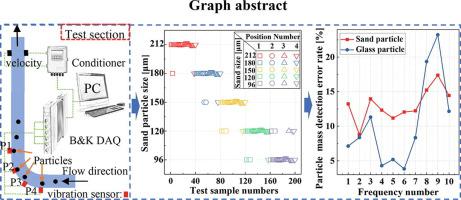Chemical Engineering Journal ( IF 13.3 ) Pub Date : 2020-10-28 , DOI: 10.1016/j.cej.2020.127526 Kai Wang , Yinan Hu , Zhiyuan Wang , Min Qin , Gang Liu , Yichen Li , Gang Wang

|
Particle-wall interaction behaviour is related to the optimization of chemical and petroleum production, and the real-time characterization of particles in liquid flow by accurate and convenient methods is still a challenge worldwide. In this work, the particle-wall behaviours collision and friction were distinguished from water flow behaviours based on a time-frequency method at four pipe positions. The specific refined frequency responses were calculated by zoom fast Fourier transform (Zoom-FFT) and multiscale frequency analysis methods, and eigenvectors were established based on the corresponding time-domain statistics. The test positions, flow velocities and particle sizes were auto-classified. A verification experiment was performed, and good agreement was found between the content (0.05-0.2 wt.%) of particles with a size range of 96-212 μm and the vibration response of ten discovered particle multiscale frequencies ranging from 43.2-50 kHz. In particular, high recognition rates were obtained for the different test positions (94.45 %), flow velocities (95.33 %), and particle sizes (91.00 %) by the support vector machine (SVM) method. The best three characteristic particle frequency bands were 45.6-46.4 kHz, 46.4-47.2 kHz and 47.2-48.0 kHz in the elbow. The relevant sand content detection error rates were 9.57 %, 4.81 %, and 6.78 %, which were improved greatly compared with those of our previous method. Therefore, this study complements the existing techniques and knowledge for particle characterization in multiphase flow.
中文翻译:

使用非侵入式振动检测方法对固液分散输送管道中颗粒-壁相互作用的多频率表征
颗粒与壁之间的相互作用行为与化学和石油生产的优化有关,通过精确,便捷的方法实时表征液体流动中的颗粒仍然是世界范围内的挑战。在这项工作中,基于时频方法,在四个管道位置,将颗粒-壁行为与水的流动行为相区别。通过缩放快速傅里叶变换(Zoom-FFT)和多尺度频率分析方法计算出特定的精细频率响应,并基于相应的时域统计量建立特征向量。测试位置,流速和粒径自动分类。进行验证实验,发现含量之间(0.05-0.2重量%。%)的粒径范围为96-212μm的颗粒,以及十个发现的多尺度频率范围为43.2-50 kHz的振动响应。特别是,通过支持向量机(SVM)方法获得的不同测试位置(94.45%),流速(95.33%)和粒径(91.00%)的识别率很高。弯头中最好的三个特征粒子频带是45.6-46.4 kHz,46.4-47.2 kHz和47.2-48.0 kHz。相应的含砂量检测错误率分别为9.57%,4.81%和6.78%,与我们以前的方法相比有很大的提高。因此,本研究补充了多相流中颗粒表征的现有技术和知识。通过支持向量机(SVM)方法获得的不同测试位置(94.45%),流速(95.33%)和粒径(91.00%)的识别率很高。弯头中最好的三个特征粒子频带是45.6-46.4 kHz,46.4-47.2 kHz和47.2-48.0 kHz。相应的含砂量检测错误率分别为9.57%,4.81%和6.78%,与我们以前的方法相比有很大的提高。因此,本研究补充了多相流中颗粒表征的现有技术和知识。通过支持向量机(SVM)方法获得的不同测试位置(94.45%),流速(95.33%)和粒径(91.00%)的识别率很高。弯头中最好的三个特征粒子频带是45.6-46.4 kHz,46.4-47.2 kHz和47.2-48.0 kHz。相应的含砂量检测错误率分别为9.57%,4.81%和6.78%,与我们以前的方法相比有很大的提高。因此,本研究补充了多相流中颗粒表征的现有技术和知识。弯头为0 kHz。相应的含砂量检测错误率分别为9.57%,4.81%和6.78%,与我们以前的方法相比有很大的提高。因此,本研究补充了多相流中颗粒表征的现有技术和知识。弯头为0 kHz。相应的含砂量检测错误率分别为9.57%,4.81%和6.78%,与我们以前的方法相比有很大的提高。因此,本研究补充了多相流中颗粒表征的现有技术和知识。











































 京公网安备 11010802027423号
京公网安备 11010802027423号